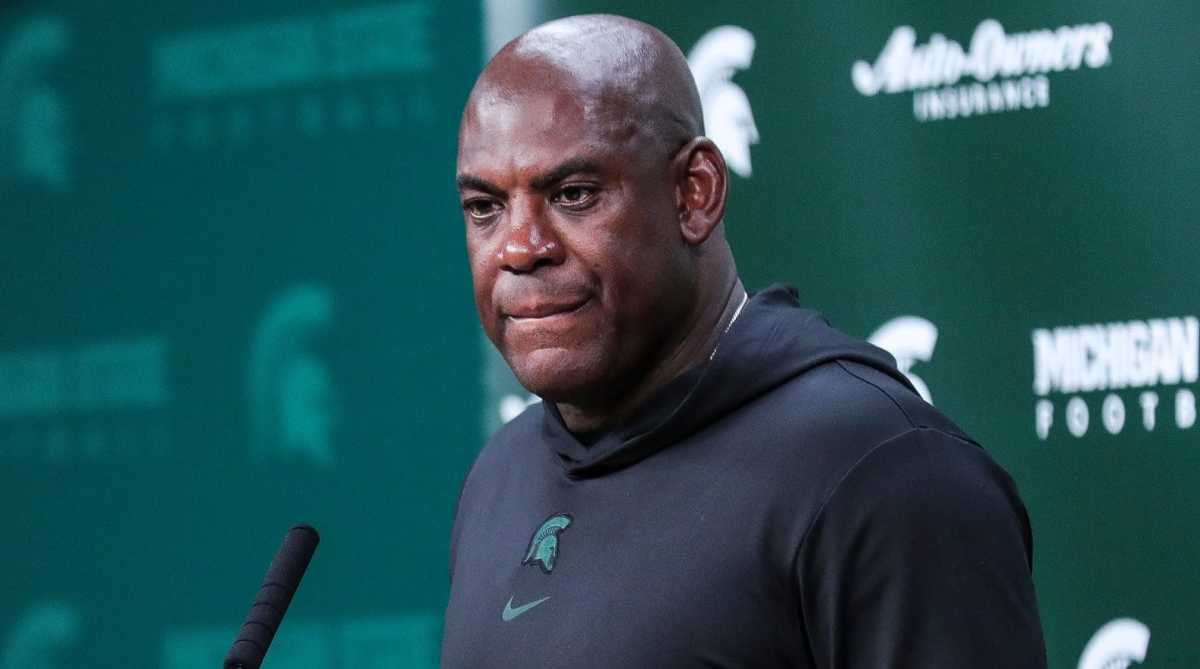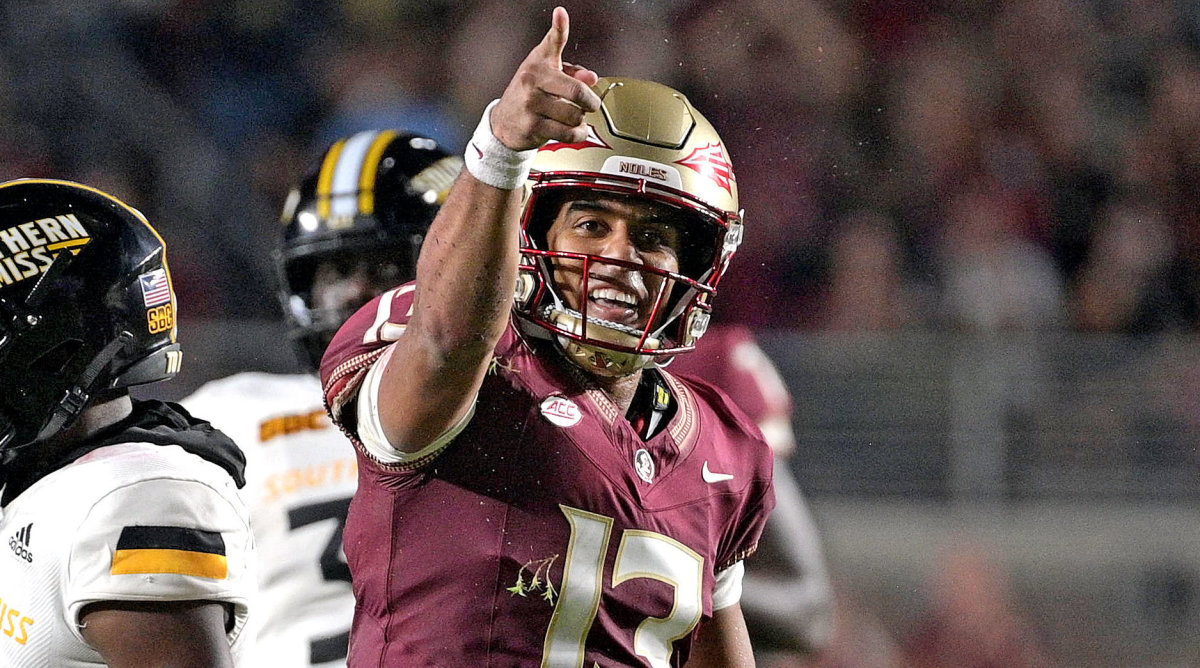All Signs Point Toward Mel Tucker’s Eventual Dismissal From Michigan State

Forty names, games, teams and minutiae making news in college football (playoff highlight videos from 2015–20 sold separately in Tuscaloosa and Clemson):
Second Quarter: The SEC Stinks | Third Quarter: Checking the Panic Meter
FIRST QUARTER: THE MESS IN EAST LANSING
On Oct. 30, 2021, Mel Tucker (1) and Michigan State were on top of the world. The Spartans defeated hated rival Michigan 37–33 in a wildly entertaining game in a raucous Spartan Stadium, improving to 8–0 on the season and rising to No. 3 in the AP poll.
Less than three weeks later, with Tucker considered a hot commodity on the coaching market, the school stunned the industry by giving him a 10-year, $95 million contract. Michigan State finished the season 11–2 and ranked No. 9. Tucker was wildly popular, set for life financially and seemingly on the verge of carving out a spot in the highest echelon in his profession.
That seems like a long time ago now.
On Sunday, Michigan State athletic director Alan Haller (2) announced that he is suspending Tucker without pay pending results of an October hearing that will determine whether the coach violated the school’s sexual harassment policy. The hearing follows an investigation into claims that Tucker sexually harassed Brenda Tracy, a nationally known sexual assault prevention advocate who had been brought in by Tucker multiple times to speak to the Spartans football team.
The school hired an outside Title IX attorney to investigate the complaint. The details of Tracy’s allegations against Tucker were published Saturday night by USA Today. Tucker told the investigator that he and Tracy discussed having a romantic relationship and that their interactions were consensual; she says his advances were unwelcome.
The outcome of the hearing could materially affect Tucker’s ability to collect on the remaining $77-plus million on his contract, but even a favorable ruling for him might not be enough to save his job. This will be a difficult situation for Tucker to come back from at Michigan State.

Assistant coach Harlon Barnett (3) has been named interim coach, but the decision to bring back former head coach Mark Dantonio (4) as an associate coach would seem to be an indication that Tucker is not expected back. Maybe Dantonio is willing to simply serve three games as a stopgap sounding board, but that has the feel of a season-long move to give Barnett the backing of a program hero who has won 132 games as a college head coach.
The investigation into Tucker’s relationship with Tracy began when she filed a complaint last December. The question foremost on many minds Sunday was why Michigan State failed to act before now, when USA Today’s report forced the school’s hand. The story says the investigation was completed in July; Haller disputed that Sunday by saying the investigation is ongoing, and a school spokeswoman told ESPN’s Dan Murphy that while the school’s leadership knew in December a complaint had been filed against Tucker, they did not know any details until Saturday night.
That notion may be hard to believe, but it’s even more difficult to fathom that Michigan State would think this investigation and the subsequent hearing could be carried to its conclusion in secrecy. It seems unlikely that the school was simply trying to bury something that was impossible to bury. Michigan State could have done a better job explaining what it did or did not know up front, which would have helped to combat the perception that it simply let Tucker coach until the day the investigation became public.
Earlier this summer, Northwestern quickly caved to bad publicity shortly after details of the school’s hazing investigation were disseminated by the school’s student newspaper. Coach Pat Fitzgerald rapidly went from suspended to fired after that report. If Michigan State copied that playbook it was a disastrous decision.
It seems more likely that the school simply was trying to let the investigative process take its course. But in the end, it seems likely that Tucker is done at Michigan State.
It is a precipitous, humiliating fall for Tucker and another dose of bad P.R. for a school that disgraced itself during the Larry Nassar scandal. From a purely financial-and-football perspective, this also could be a $77 million gift. Tucker was never worth that money, and the school could be free to move on without paying a massive buyout.
Since that high-water mark against Michigan in 2021, Tucker’s record is 10–9. The Spartans were a dismal 5–7 last year, and then their two best offensive players unexpectedly hit the transfer portal. Michigan State’s 2–0 start to this season is built on bad competition; nobody expects this team to challenge Michigan, Ohio State and Penn State in the Big Ten East Division.
So the shine was already off Mel Tucker the football coach. Now his personal reputation has taken a hit. A guy who seemingly had everything less than two years ago now stands in jeopardy of giving it all away.
IF THE MICHIGAN STATE JOB OPENS …
This could go any number of directions. But here are a couple of schools of thought the Spartans could entertain.
One is in the neighborhood: Toledo coach Jason Candle (5), who is 55–33 at the school and probably has the best team in the Mid-American Conference again this season. Candle has spent his entire career recruiting the Midwest.
Or there are the coaches of the Pac-2 (6). Both Jonathan Smith of Oregon State and Jake Dickert of Washington State have proven themselves in tough jobs that are about to get tougher. They could be looking to move, given the demise of the Pac-12. Dickert (12–9 at Washington State) is a Midwestern guy who has now upset Wisconsin in consecutive seasons. Smith (29–31 at Oregon State but 12–3 in his last 15 games) is a career West Coast player and coach but has shown he knows what he’s doing.
FOUR FOR THE PLAYOFF
Each week, The Dash selects the College Football Playoff bracket as if today were Selection Sunday. Reminder: preseason expectations have been tossed and selections are based on actual games played to date.

Sugar Bowl: top seed Florida State (7) vs. fourth seed Notre Dame (8).
The Seminoles (2–0) have the most impressive performance to date in blowing out LSU, 45–24. Their offense has been clicking for quite some time now, dating back to midway through last season—they’ve scored 35 or more points eight straight games, the longest active streak in the nation. Next up for Florida State: at Boston College, which is in contention to be the worst team in the ACC.
The Fighting Irish (3–0) earned their playoff cred by romping past North Carolina State, 45-24, in Raleigh on Saturday. Notre Dame is a well-rounded team thus far, averaging 8.05 yards per play on offense and allowing just 3.5. Transfer quarterback Sam Hartman is second nationally in pass efficiency, trailing only USC’s Caleb Williams. Next up for Notre Dame: Central Michigan, the last prelude to the showdown with Ohio State on Sept. 23..
Rose Bowl: second seed Texas (9) vs. third seed Colorado (10).
The Longhorns (2–0) planted their flag in the heart of SEC country Saturday night with a resounding victory at Alabama. Are they back? For now, you bet. This is a good defensive team with plenty of offensive skill, which means the Longhorns should be capable of winning shootouts or slugfests. They have the pieces. Next up for Texas: Wyoming.
The Buffaloes (2–0) are one of just two teams to have a pair of victories over Power Five opponents—TCU in the opener and Nebraska in a 36–14 thumping Saturday. Colorado is a fun story, but there is substance to the Buffs. They have talent—especially at quarterback and the skill positions—and they’ve shown an ability to produce in pressure situations. Being a plus-four in turnover margin doesn’t hurt. Next up for Colorado: Colorado State.
Also considered: Utah, Duke, Oregon, Ohio State, North Carolina, Cincinnati, Iowa.
Dropped out from last week: Utah, North Carolina.
Second Quarter: SEC Kind of Stinks | Third Quarter: Checking the Panic Meter
